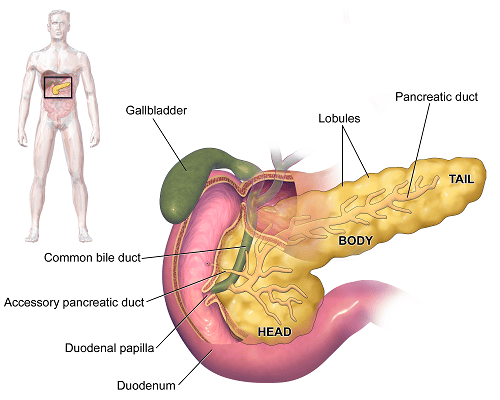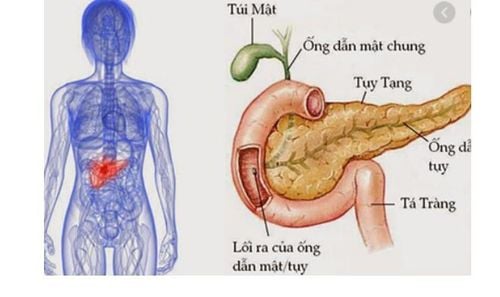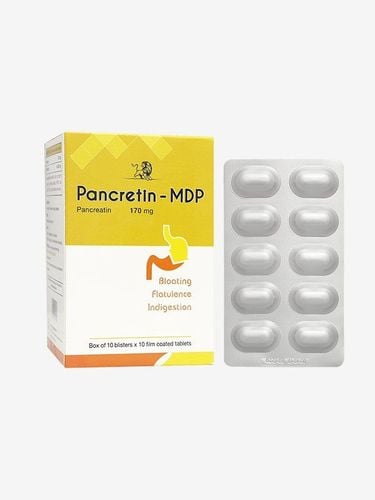This is an automatically translated article.
The article was professionally consulted by Specialist Doctor I Dong Xuan Ha - Digestive Endoscopy Doctor - Department of Medical Examination and Internal Medicine - Vinmec Ha Long International HospitalPancreatic head tumor is a very dangerous disease, besides causing obstructive jaundice, pancreatic head tumor also causes other dangerous complications. If not handled properly and in time, it will not restore the central nervous system and cause severe neuropsychiatric sequelae and disability.
1. The role of the pancreas in the body
We know that the pancreas is a hammer-shaped organ consisting of three parts: head, body and tail. Pancreas weight about 80g, average size 15cm long, 6cm high, 3cm thick. The pancreas is located below the stomach and in front of the spine.In the pancreas, there are two groups of cells: exocrine pancreatic cells (which secrete enzymes into the small intestine to digest food) and endocrine pancreatic cells (which secrete a variety of hormones into the bloodstream to affect organs). destination). The hormone-secreting cells of the pancreas form groups known as the islets of Langerhans.
Trắc nghiệm: Bạn biết gì về các yếu tố nguy cơ, chẩn đoán và điều trị ung thư tuyến tụy?
Ung thư tuyến tụy phổ biến thứ 10 trong những bệnh ung thư mới và là nguyên nhân thứ 4 gây tử vong do ung thư ở nam, nữ. Bài trắc nghiệm này sẽ kiểm tra kiến thức của bạn về các yếu tố nguy cơ, chẩn đoán và cách điều trị ung thư tuyến tụy.
Bài viết tham khảo nguồn: medicalnewstoday 2019
2. Is pancreatic head tumor dangerous?
Endocrine pancreatic tumor is a rare disease that severely affects the quality of life as well as the life of patients.This is a very serious endocrine disease, if not handled properly and promptly, these prolonged episodes of hypoglycemia will permanently damage the central nervous system and cause mental sequelae. severe epilepsy and disability in children.
Pancreatic tumors are divided into 2 types: benign tumors and malignant tumors. Benign pancreatic tumors are rare, slow-growing and non-metastatic, while pancreatic cancer is a particularly dangerous malignancy, ranking second in the causes of death from gastrointestinal cancer. after colorectal cancer.
Cancer can develop in any part of the pancreas, most commonly cancer of the head of the pancreas. Pancreatic tail cancer is the least common, accounting for only 5-10% of cases. In general, pancreatic cancer, no matter where it starts, is very dangerous.
However, compared with other sites, pancreatic head cancer is evaluated as having disease symptoms that often appear earlier than pancreatic body and tail cancer, the surgical resection rate is higher and the prognosis is also better. .

3. Symptoms of pancreatic head tumor
Pancreatic head tumor compresses the bile, causing the patient to have some symptoms such as:Jaundice, itchy skin Discolored stools Diarrhea Fatty stools The patient feels pain in the epigastrium, the pain may spread to the back when the cancer is present. Invasive retroperitoneal plexus cancer When invasive cancer presses on the duodenum, the patient will feel vomiting, upper gastrointestinal bleeding... In general, pancreatic cancer is very dangerous, even in early stage cancer. The prognosis for patients with pancreatic cancer stage I is only about 12-14%, stage II about 5-7%, stage III about 3% and in the final stage, the 5-year survival prognosis after diagnosis is only about 5 years. first%.
4. Should pancreatic head tumor be operated?
The choice of treatment for pancreatic cancer depends on many factors. Depending on the individual case, the doctor will prescribe the appropriate treatment method. Some methods that may be prescribed by a doctor are:Surgery: surgery is one of the main treatments for patients with early stage pancreatic cancer. Depending on the specific case, the doctor will recommend removing part or all of the pancreas. Only about 20% of patients with pancreatic cancer meet the requirements for surgery because most cases are diagnosed at a late or metastatic stage. Chemotherapy: Using chemotherapy to stop cancer from growing. However, pancreatic cancer is less sensitive to chemotherapy than some other cancers. Radiation therapy: uses radiation therapy to kill cancer cells. In addition, chemotherapy drugs have the effect of increasing the sensitivity of radiation. After surgery, the patient needs to rest, eat a healthy, suitable diet and sometimes need to add digestive enzymes or insulin to make up for the deficiency of the body due to the removed pancreas.
Chemotherapy can help kill or slow the growth of cancer cells and is widely used in the treatment of pancreatic cancer. In some patients, chemotherapy may be given as an adjuvant (after resection) or neoadjuvant treatment (before resection). Sometimes chemotherapy is combined with radiation therapy, also known as concurrent chemoradiotherapy.
After treatment, the patient should be scheduled for regular check-ups to detect the disease's return early. A CA19.9 test along with a CT/scan should be done periodically or when the patient has any other symptoms.
Vinmec International General Hospital is one of the hospitals that not only ensures professional quality with a team of doctors, modern equipment and technology. The hospital provides comprehensive, professional medical examination, consultation and treatment services, civilized, polite, safe and maximum sterilization space. Customers when choosing to perform tests here can be completely assured of the accuracy of test results.
Please dial HOTLINE for more information or register for an appointment HERE. Download MyVinmec app to make appointments faster and to manage your bookings easily.














